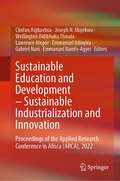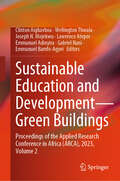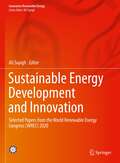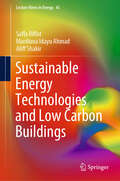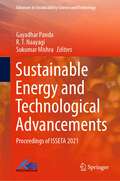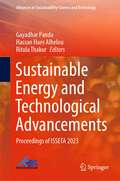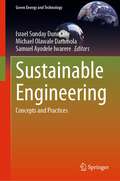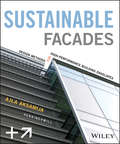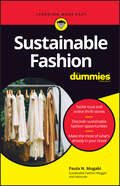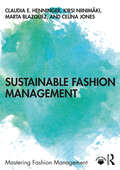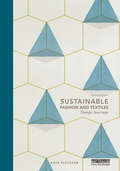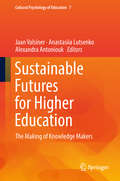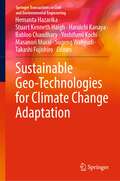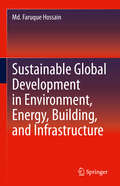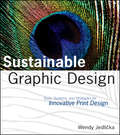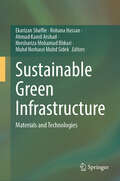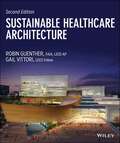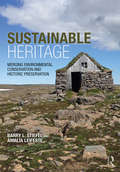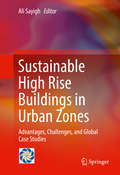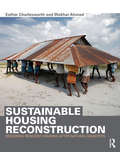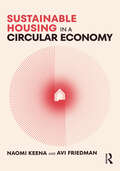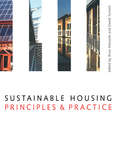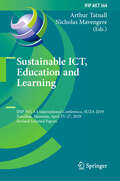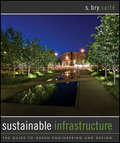- Table View
- List View
Sustainable Education and Development – Sustainable Industrialization and Innovation: Proceedings of the Applied Research Conference in Africa (ARCA), 2022
by Clinton Aigbavboa Wellington Didibhuku Thwala Joseph N. Mojekwu Lawrence Atepor Emmanuel Bamfo-Agyei Emmanuel Adinyira Gabriel NaniThis book presents papers from the 11th Sustainable Education and Development Research Conference on the theme: "Build Resilient Infrastructure, Promote Inclusive and Sustainable Industrialization, and Foster Innovation." Papers related to the sub-themes were presented: i. Develop quality, reliable, sustainable, and resilient infrastructure, including regional and transborder infrastructure, to support economic development and human well-being, with a focus on affordable and equitable access for all. ii. Promote inclusive and sustainable industrialization and, by 2030, significantly raise industry's share of employment and gross domestic product, in line with national circumstances, and double its share in the least developed countries. iii. Increase the access of small-scale industrial and other enterprises, in particular in developing countries, to financial services, including affordable credit, and their integration into value chains and markets. iv. By 2030, upgrade infrastructure and retrofit industries to make them sustainable, with increased resource-use efficiency and greater adoption of clean and environmentally sound technologies and industrial processes, with all countries taking action in accordance with their respective capabilities. v. Enhance scientific research and upgrade the technological capabilities of industrial sectors in all countries, in particular developing countries, including, by 2030, encouraging innovation and substantially increasing productivity.SEDRC gathers papers that explain how key education on the Sustainable Development Goals is transforming lives, eradicating poverty, professing solutions to the infrastructural deficit in Africa, and providing innovative ways to provide affordable housing in Africa.This book will be of interest to academics, postgraduate students, and industry professionals.
Sustainable Education and Development—Green Buildings: Proceedings of the Applied Research Conference in Africa (ARCA), 2023, Volume 2
by Clinton Aigbavboa Wellington Thwala Joseph N. Mojekwu Lawrence Atepor Emmanuel Bamfo-Agyei Emmanuel Adinyira Gabriel NaniThis book is Volume 2 of the proceedings of 2023 Sustainable Education and Development Research Conference. This volume concentrates on papers in the area of green buildings. Despite considerable progress, more than 700 million people worldwide still lack access to electricity, and around 2.4 billion people continue to use harmful and polluting fuels for cooking. While efforts have been made to promote renewable energy and energy efficiency, they have not been fast enough to achieve Sustainable Development Goal 7. Adding to the challenge, the ongoing war in Ukraine has contributed to rising global energy prices and heightened energy insecurity in Europe. In response to the energy crisis, some European countries are planning to accelerate the transition to renewables and increase investments in clean energy and energy efficiency. However, others are considering a resurgence of coal, which poses a risk to the overall green transition. Between 2010 and 2020, the percentage of the global population with access to electricity increased from 83% to 91%, with 1.3 billion people gaining access. Nevertheless, this leaves approximately 733 million people still without electricity, and most of them reside in sub-Saharan Africa. Achieving universal access by 2030, the annual growth rate in access needs to accelerate from 0.5 percentage points to 0.9 percentage points, necessitating significant efforts in low-income, fragile, and conflict-affected countries. In 2020, 69% of the global population had access to clean cooking fuels and technologies. While more than half of those without access to clean cooking fuels live in Asia, the 20 countries with the lowest percentage of people having access to clean cooking were predominantly least developed countries in Africa. The share of renewable sources in total final energy consumption reached 17.7% globally in 2019, just slightly higher than the figure for 2015. The electricity sector leads in the adoption of renewables, accounting for 26.2% of total final energy consumption in 2019, while the heat and transport sectors have made limited progress. Global primary energy intensity, defined as global total energy supply per unit of GDP, improved from 5.6 megajoules per dollar (2017 purchasing power parity) in 2010 to 4.7 megajoules in 2019. However, the rate of improvement (1.6% per year on average since 2015) falls short of the 3.2% annual rate needed to reach Sustainable Development Goal 7.3. International financial flows to support clean and renewable energy in developing countries reached $10.9 billion in 2019, a 23.6% decrease from 2018. This decline occurred even before the onset of the COVID-19 pandemic. Over a longer five-year moving average, average annual commitments decreased for the first time since 2008, from $17.5 billion in 2014-18 to $16.6 billion in 2015-19. Although developing countries achieved a record of 245.7 watts per capita in installed renewable energy-generating capacity in 2020, small island developing States, least developed countries, and landlocked developing countries have lagged behind. It would take least developed countries and landlocked developing countries nearly 40 years and small island developing States almost 15 years to reach the same level of progress as the average developing country in 2020. The 2023 SEDRC conference, titled "Sustainable Development and Education," aims to redefine the understanding of research in the continent's development and the role of researchers. The conference focusses on applied research discussions and its dissemination. Researchers from research institutions, academicians, postgraduate students, politicians, and industry representatives will be the primary audience for the conference proceedings.
Sustainable Energy Development and Innovation: Selected Papers from the World Renewable Energy Congress (WREC) 2020 (Innovative Renewable Energy)
by Ali SayighThis book contains selected papers presented during the World Renewable Energy Congress (WREC) 2020 at the Instituto Superior Técnico in Lisbon. The WREC is dedicated to promoting renewable energy global development, and features top international experts, policy makers, scientists, engineers, technology developers, and business practitioners addressing the most current research and technological breakthroughs in sustainable energy development and innovation. The contributions address policy and renewable energy technologies and applications in all sectors—for heating and cooling, agricultural applications, water, desalination, industrial applications, and for the transport sectors.Presents cutting-edge research in green building and renewable energy from all over the world;Covers the most up-to-date research developments, government policies, business models, best practices, and innovations;Contains case studies and examples to enhance practical application of the technologies.
Sustainable Energy Technologies and Low Carbon Buildings (Lecture Notes in Energy #45)
by Mardiana Idayu Ahmad Saffa Riffat Aliff ShakirThis book aims to offer an in-depth guide and fundamental comprehension of sustainable energy technologies and their essential function in decreasing energy consumption in buildings under diverse climatic conditions. It has been designed to stimulate additional research and innovation, especially in the field of green technology for building applications. This book embodies the culmination of extensive research and case studies, encompassing the initial developments to the latest advancements in sustainable energy systems, particularly emphasising energy-efficient building technologies. It also highlights up-to-date reviews and research into meeting low and zero carbon demand in buildings and includes extensive coverage of established and emerging sustainable energy technologies for building applications, addressing their physical principles, mechanisms, applications, and cutting-edge technological advances. The coverage of book is divided into five main parts: Thermal energy-efficient systems; Sustainable power generation; Energy-efficient lighting technologies; Zero-energy and low carbon buildings and; Eco-cities as sustainable urban living. Taken together, they provide a concise explanation of low and zero carbon buildings’ role in tackling the world’s energy challenges, with an emphasis on design, conversion techniques, and materials and on the economic and environmental assessment of technology. Innovative concepts, design, and planning in connection with global urbanization and improving sustainable development are also discussed. In addition, the book features case studies on worldwide sustainable energy technologies, low and zero carbon buildings, and eco-cities as sustainable urban environments. This book offers a valuable source of information for developers, architects, building managers and owners, and engineers working in sustainable energy fields, as it provides in-depth information on a diverse range of technologies designed to achieve environmentally friendly solutions. The book also benefits students and academics, as it offers optimal supporting material for an introductory course in this field.
Sustainable Energy and Technological Advancements: Proceedings of ISSETA 2021 (Advances in Sustainability Science and Technology)
by Sukumar Mishra Gayadhar Panda R. T. NaayagiThis book contains selected papers presented at the First International Symposium on Sustainable Energy and Technological Advancements (ISSETA 2021), which was organized by the Department of Electrical Engineering, NIT Meghalaya, Shillong, India, during September 24–25, 2021. The topics covered in the book mainly focuses on the cutting-edge research domain with respect to sustainable energy technologies, smart building, integration, and application of multiple energy sources; advanced power converter topologies and their modulation techniques; and information and communication technologies for smart microgrids.
Sustainable Energy and Technological Advancements: Proceedings of ISSETA 2023 (Advances in Sustainability Science and Technology)
by Hassan Haes Alhelou Gayadhar Panda Ritula ThakurThis book contains selected papers presented at Second International Symposium on Sustainable Energy and Technological Advancements (ISSETA 2023), organized by the Department of Electrical Engineering, NIT Meghalaya, Shillong, India, during February 24–25, 2023. The topics covered in the book are the cutting-edge research involved in sustainable energy technologies, smart building technology, integration and application of multiple energy sources; advanced power converter topologies and their modulation techniques; and information and communication technologies for smart micro-grids.
Sustainable Engineering: Concepts and Practices (Green Energy and Technology)
by Israel Sunday Dunmade Michael Olawale Daramola Samuel Ayodele IwarereSustainable Engineering: Concepts and Practices provides insights into current perspectives on sustainable engineering research. It highlights the drivers, motivations, and challenges affecting the development and adoption of sustainable engineering in various sectors of the economy and how they impact sustainable development. Contributions from researchers representing multiple branches of engineering in academia, government laboratories, and industry present alternative approaches to traditional engineering practices. These approaches effect change, making the design, construction, production, and management of products, processes, and systems more environmentally friendly, socially beneficial, and economically profitable. The book will be a trusted reference for graduate students, practicing engineers, and other professionals interested in developing or using sustainable products and systems.
Sustainable Facades
by Ajla AksamijaPractical information on designing sustainable, energy-efficient building facadesAs energy and other natural resources are being depleted, it has become clear that technologies and strategies that allow us to maintain our satisfaction with interior environments while consuming less of these resources are major objectives of contemporary facade design. Sustainable Facades focuses on the strategies and approaches for designing sustainable, high-performance building facades, and provides technical guidance for architects and designers.This timely and useful guide presents strategies and technical guidelines for designing environmentally sensitive, energy-efficient facades based on scientific principles. It provides climate-specific approaches for minimizing energy consumption, analyzes the thermal behavior of different facade systems and materials, and illustrates with case studies how these approaches have been implemented on architectural projects. It also discusses emerging facade technologies, materials, and systems.Topics covered in this unique and indispensable guide include:Climate-based design approaches for high-performance facadesCharacteristics of sustainable facades: energy efficiency, thermal behavior, and moisture resistanceDesigning for thermal comfort, lighting and glare control, and acoustic qualityEmerging technologies in facade design, including smart materials, double-skin facades, and facades as energy generatorsCase studies on building orientation and facade design, tectonic sun exposure control, external shading elements, and more
Sustainable Fashion For Dummies
by Paula N. MugabiDitch fast fashion and create a more sustainable wardrobe Want to learn how to make more ethical fashion choices? Sustainable Fashion For Dummies will teach you how to pick up new habits that align with a more sustainable future. The rise of fast fashion in recent years has contributed to unsafe work environments, unfair wages, and toxic pollution. With sustainable fashion, you can have groovy clothing and accessories that are produced in an ecologically and socially responsible manner, using quality products and long-lasting materials. You don’t have to sacrifice your natural fashion sense—the sustainable fashion movement is responsible for some of the most exciting new trends. Pick up this easy-to-read handbook for practical tips and strategies on making more environmentally friendly fashion choices. Get started on your sustainable fashion journey Discover inexpensive options for making more eco-friendly fashion choices Make the most of what's already in your closet Master the art of thrift shoppingLet this Dummies guide be your guru as you start making socially and environmentally friendly fashion choices and becoming more thoughtful about what you purchase (or don’t purchase).
Sustainable Fashion Management (Mastering Fashion Management)
by Claudia E. Henninger Marta Blazquez Kirsi Niinimäki Celina JonesThis book provides a holistic and accessible approach to sustainable fashion management. It offers an interdisciplinary and practical outlook, combining theory with practical application from a management perspective and underpinned by the Sustainable Development Goals throughout. The book helps students to gain a better understanding of what sustainable fashion is and how it is implemented across the fashion industry, through business model innovations, innovative designs, new technology and digital approaches, and material innovations. Global case studies are employed throughout each chapter, including fashion companies and events of all sizes, alongside other pedagogical features to aid learning, including key learning points, chapter objectives, and textboxes explaining key terminology. This is an essential textbook for those investigating sustainable fashion, whether from a design or management perspective, providing the knowledge and tools for a future career. It is designed to serve Fashion Business and Management, Fashion Marketing, Fashion Buying and Merchandising and Fashion Technology courses, at all levels, and will also be valuable reading for those already working within the fashion industry and studying for professional qualifications. Online resources include chapter-by-chapter PowerPoint slides and a test bank.
Sustainable Fashion and Textiles: Design Journeys
by Kate FletcherFully revised and updated, the second edition of Sustainable Fashion and Textiles: Design Journeys continues to define the field of design in fashion and textiles. Arranged in two sections, the first four chapters represent key stages of the lifecycle: material cultivation/extraction, production, use and disposal. The remaining four chapters explore design approaches for altering the scale and nature of consumption, including service design, localism, speed and user involvement. While each chapter is complete in and of itself, their real value comes from what they represent together: innovative ways of thinking about textiles and garments based on sustainability values and an interconnected approach to design. Including a new preface, updated content and a new conclusion reflecting and critiquing developments in the field, as well as discussing future developments, the second edition promises to provide further impetus for future change, sealing Sustainable Fashion and Textiles: Design Journeys as the must-buy book for fashion and textiles professionals and students interested in sustainability.
Sustainable Futures for Higher Education: The Making of Knowledge Makers (Cultural Psychology of Education #7)
by Jaan Valsiner Anastasiia Lutsenko Alexandra AntonioukThis volume addresses the current situation in higher education and what creative action needs to be taken for the future development of the various systems of higher education. Higher education in the 21st centuries is under immense pressure from various sides. First, there is dramatic limitation of funding from public sources and limited and selective funding support from private sources that is re-constructing the landscape of higher education in most societies around the World. Secondly there is the continuous stream of administrative re-organization efforts of political origins (e.g. “the Bologna process”) that guide the advancement of higher education in our present time. Increasing privatization of all forms of higher education—from bachelor to doctoral levels—and its corresponding focus on the advancement of the kind of knowledge that has immediate applicability in various spheres of societies leads to the question- what kind of creativity is expected from the new cohorts of students—future makers of knowledge—once the current social re-organization of higher education systems becomes fully established. To address these questions the international, interdisciplinary cast of authors in this volume provides a multitude of possible scenarios for future development of the systems of higher education. This book on “Sustainable Futures of Higher Education” captures the current trends and perspectives of the Knowledge Makers from various nations of the world on meeting and greeting the challenges of globalization and the pressures of the knowledge economy. It makes a strong case for universities of tomorrow sustaining their autonomous thinking and yet nurturing an environment of collaborative partnership with society, corporate and industry to fuel innovations in plenty and continuous supply of new science and technologies. Higher Education has been and shall remain a powerful vehicle of national and global transformation. I see a great value of the publication in impacting the minds of the leaders in higher education around the globe for revitalizing the universities.Professor P. B Sharma, President of Association of Indian Universities, AIU How should the higher education system be in the globalization era? In this book Jaan Valsiner and his colleagues analyze, criticize the existing and propose a new higher education system. When we say "higher education”, three different layers are supposed to be there-- the lower, the middle and the higher. The latter has the function of production of new knowledges. Without new knowledge, our societies are never improving. Authors warn commercialized systems such as the “Bologna system” overestimate the homogeneity of education. ““Universities without Borders” would guarantee both diversity and innovation in the higher education systems.Professor Tatsuya Sato, Dean of Research, Ritsumekan University
Sustainable Geo-Technologies for Climate Change Adaptation (Springer Transactions in Civil and Environmental Engineering)
by Hemanta Hazarika Stuart Kenneth Haigh Haruichi Kanaya Babloo Chaudhary Yoshifumi Kochi Masanori Murai Sugeng Wahyudi Takashi FujishiroThis edited volume is a compilation of peer-reviewed papers of the plenary lectures, keynote lectures, special lectures and young researcher’s special lectures delivered at the 1st International Symposium on Construction Resources for Environmentally Sustainable Technologies (CREST 2020) organized by Kyushu University, Fukuoka, Japan. The book focuses on sustainability, promotion of new ideas and innovations in design, construction and maintenance of geotechnical structures with the aim of contributing towards climate change adaptation and disaster resiliency to meet the UN Sustainable Development Goals (SDGs). It presents latest research, information, technological advancement, practical challenges encountered, and solutions adopted in the field of geotechnical engineering for sustainable infrastructure towards climate change adaptation. This volume will be of interest to those in academia and industry alike.
Sustainable Global Development in Environment, Energy, Building, and Infrastructure
by Md. Faruque HossainThis book emphasizes the comprehensive application of sustainability for all sectors of Environment, Energy, Building, and Infrastructure to secure a well-balanced world. Hence, the goal of this book is to define the context of instigation to think through the scientific theories and practical technical applications of the sustainable mechanism to confirm the global sustainability by implementation of the following six themes, Chapter 1: Introduction; Chapter 2: Sustainable Environment; Chapter 3: Sustainable Energy; Chapter 4. Sustainable Building; 5. Sustainable Infrastructure; Chapter 6: Conclusion; which are very much interconnected to secure the global sustainability. Consequently, the importance of the application of sustainability in all sectors of these six sectors has been expedited in this book considering the wise application of technologies by trickling down the advancement thoughts, research, and practices to achieve a broader result to build a better world.
Sustainable Graphic Design
by Wendy JedlickaThe graphic artist's guide to sustainable designGraphic design is frequently thought of as a purely decorative effort. Yet these efforts can be responsible for shocking impacts on natural resources just to produce a barely-glanced-at catalog or mail piece. Sustainable Graphic Design: Tools, Systems, and Strategies for Innovative Print Design helps designers view graphic design as a holistic process. By exploring eco-conscious materials and production techniques, it shows designers how to create more effective and more sustainable designs.Sustainable Graphic Design opens your eyes to the bigger picture of design seen from the viewpoints of the audience, the creative vendor, their suppliers, and society as a whole. Chapters are written by a wide range of sustainable design pioneers and practitioners--including graphic designers, creative managers, marketing consultants, environmentalists, researchers, and psychologists--giving you critical information on materials and processes. Case studies illustrate and tie concepts together.Sustainability isn't a fad or a movement; it's a long-term paradigm shift. With this forward-looking toolkit, you'll be able to infuse your work with sustainability systems thinking, empowering you to play your role in achieving a future where design and sustainability are natural partners.ContributorsPaul AndrePaul J. BeckmannSharell BensonArlene BirtRobert CallifDon CarliJeremy FaludiTerry GipsFred HabermanDan HalseyJessica JonesCurt McNamaraJohn MoesJacquelyn OttmanHolly RobbinsPamela SmithDion ZuessBiomimicry GuildCarbonless PromiseChlorine Free Products AssociationEnvironmental Paper NetworkEureka RecyclingGreat Printer Environmental InitiativePackage Design MagazinePromotional Product SolutionsSustainable Green Printing PartnershipSustainable Packaging Coalition
Sustainable Green Infrastructure: Materials and Technologies
by Rohana Hassan Ahmad Kamil Arshad Muhd Norhasri Muhd Sidek Norshariza Mohamad Bhkari Ekarizan ShaffieThis book highlights the integration of eco-friendly infrastructure, innovative materials, and advanced technologies to build sustainability and resilience in both urban and rural environments. It explores the sustainability principles, highlighting how green infrastructure can reduce environmental impacts, improve quality of life, and ensure long-term ecological balance. The text emphasizes the importance of technological innovations in achieving sustainable development goals, offering insights into the latest advancements and their applications in creating resilient communities. It significantly contributes to the field by offering in-depth insights into sustainable development across various domains, including timber, pavement, construction, and technology. This volume is a crucial addition to existing literature, serving as an essential reference for future research and application in green infrastructure, materials, and technologies. Its wide-ranging content makes it an indispensable resource for professionals, scholars, and students dedicated to progressing the areas of green infrastructure and sustainable technological practices.
Sustainable Healthcare Architecture (Wiley Series in Sustainable Design #41)
by Gail Vittori Robin Guenther"With this book, Robin Guenther and Gail Vittori show us how critical our green building mission is to the future of human health and secures a lasting legacy that will continue to challenge and focus the green building movement, the healthcare industry, and the world for years to come." —From the Foreword by Rick Fedrizzi, President, CEO and Founding Chair, U.S. Green Building Council INDISPENSABLE REFERENCE FOR THE FUTURE OF SUSTAINABLE HEALTHCARE DESIGN Written by a leading healthcare architect named one of Fast Company's 100 most creative people in business and a sustainability expert recognized by Time magazine as a Green Innovator, Sustainable Healthcare Architecture, Second Edition is fully updated to incorporate the latest sustainable design approaches and information as applied to hospitals and other healthcare facilities. It is the essential guide for architects, interior designers, engineers, healthcare professionals, and administrators who want to create healthy environments for healing. Special features of this edition include: 55 new project case studies, including comparisons of key sustainability indicators for general and specialty hospitals, sub-acute and ambulatory care facilities, and mixed-use buildings New and updated guest contributor essays spanning a range of health-focused sustainable design topics Evolving research on the value proposition for sustainable healthcare buildings Profiles of five leading healthcare systems and their unique sustainability journeys, including the UK National Health Service, Kaiser Permanente, Partners HealthCare, Providence Health & Services, and Gundersen Health System Focus on the intersection of healthcare, resilience, and a health promotion imperative in the face of extreme weather events Comparison of healthcare facility-focused green building rating systems from around the world Sustainable Healthcare Architecture, Second Edition is an indispensable resource for anyone interested in the design, construction, and operation of state-of-the-art sustainable healthcare facilities.
Sustainable Heritage: Merging Environmental Conservation and Historic Preservation
by Amalia Leifeste Barry L. StiefelThis book brings together ecological-conservation theory and heritage-preservation theory and shows how these two realms have common purpose. Through theoretical discussion and illustrative examples, Sustainable Heritage reframes the history of multiple movements within preservation and sustainable-design strategies into cross-disciplinary themes. Through topics such as Cultural Relationships with Nature, Ecology, Biodiversity, Energy, and Resource Systems; Integrating Biodiversity into the Built Environment Rehabilitation Practice; Fixing the Shortcomings Within Community Design, Planning, and Policy; Strategies for Adapting Buildings and Structures for Rising Sea Levels; and Vehicles as a Microcosm of Approaching Built Environment Rehabilitation, the book explores contemporary ecological and heritage ethics as a strategy for improving the livability of the built environment. The authors provide a holistic critique of the challenges we face in light of climate and cultural changes occurring from the local to the global level. It synthesizes the best practices offered by separate disciplines as one cohesive way forward toward sustainable design. The authors consider strategies for increasing the physical and cultural longevity of the built environment, why these two are so closely paired, and the potential their overlap offers for sustained and meaningful inhabitation. Sustainable Heritage unites students and professionals in a wide range of disciplines with one common language and more closely aligned sets of objectives for preservation and sustainable design.
Sustainable High Rise Buildings in Urban Zones
by Ali SayighThis unique reference gathers numerous new studies examining specific, prominent high-rise buildings around the world. Each nuanced study included undertakes the following pivotal considerations: environmental impacts; safety & social acceptability; energy consumption and comfort; planning contexts within the urban zone; physical footprint and size; services and risks; and a careful assessment of advantages and challenges. Architects and engineers exploring and optimizing sustainable building practices, energy managers, municipal and private project planners, as well as students will find edification and inspiration in the analysis provided by esteemed practitioners and professors within this fascinating volume.
Sustainable Housing Reconstruction: Designing resilient housing after natural disasters
by Esther Charlesworth Iftekhar AhmedThrough 12 case studies from Australia, Bangladesh, Haiti, Sri Lanka, Vietnam and the USA, this book focuses on the housing reconstruction process after an earthquake, tsunami, cyclone, flood or fire. Design of post-disaster housing is not simply replacing the destroyed house but, as these case studies highlight, a means to not only build a safer house but also a more resilient community; not to simply return to the same condition as before the disaster, but an opportunity for building back better. The book explores two main themes: Housing reconstruction is most successful when involving the users in the design and construction process Housing reconstruction is most effective when it is integrated with community infrastructure, services and the means to create real livelihoods. The case studies included in this book highlight work completed by different agencies and built environment professionals in diverse disaster-affected contexts. With a global acceleration of natural disasters, often linked to accelerating climate change, there is a critical demand for robust housing solutions for vulnerable communities. This book provides professionals, policy makers and community stakeholders working in the international development and disaster risk management sectors, with an evidence-based exploration of how to add real value through the design process in housing reconstruction. Herein then, the knowledge we need to build, an approach to improve our processes, a window to understanding the complex domain of post-disaster housing reconstruction.
Sustainable Housing in a Circular Economy
by Avi Friedman Naomi KeenaThis book relates circular economy principles to housing design and construction and highlights how those principles can result in both monetary savings, positive environmental impact, and socio-ecological change.Chapters focus on three key circular economy principles and apply them to architectural construction and design, namely rethinking of the end-of-use phase of a building and the potential of design-for-disassembly; the role of digitization and data standardization in fostering evidence-based circular economy design decision-making; and presenting space as a resource to conserve, via exploration of the sharing economy and flexibility principles. Beyond waste management and material cycles, this book provides a holistic understanding of the opportunities across the building life cycle that can allow for sustainable and affordable circular housing. With case studies from 13 different countries, including but not limited to the Hammarby Sjöstad district in Sweden, the Circle House in Denmark, Benny Farm in Canada, VMD Prefabricated House in Mexico, and the Deep Performance Dwelling in China, authors pair theoretical frameworks with real-world examples.This will be a useful resource for upper-level students and academics of architecture, construction, and planning, especially those studying and researching housing design, building technology, green project management, and environmental design.
Sustainable Housing: Principles and Practice
by Brian Edwards David TurrentWritten by experts, Sustainable Housing brings new perspectives on residential sustainability, using case studies of latest practice. This book is based upon the 'Housing and Sustainability' conference at the RIBA in 1998, which intended to guide action into the next century, setting down key principles, providing important new technical information and setting UK practices in a European context.
Sustainable ICT, Education and Learning: IFIP WG 3.4 International Conference, SUZA 2019, Zanzibar, Tanzania, April 25–27, 2019, Revised Selected Papers (IFIP Advances in Information and Communication Technology #564)
by Arthur Tatnall Nicholas MavengereThis book constitutes the refereed post-conference proceedings of the First IFIP WG 3.4 International Conference on Sustainable ICT, Education, and Learning, SUZA 2019, held in Zanzibar, Tanzania, in April 2019, in conjunction with the 15th IFIP WG 9.4 International Conference on Social Implications of Computers in Developing Countries.The 27 revised full papers presented in this volume were carefully reviewed and selected from 41 submissions. The papers cover topics such as peer and collaborative learning in informatics; pedagogical approaches to teaching specific informatics courses; workplace learning related to information systems; e-learning; ICTs for development; mobile solutions in learning in the North and South; lifelong learning; applications for disabled students; traversal skills and computational thinking; and teacher education in the global South.
Sustainable Infrastructure
by S. Bry SarteAs more factors, perspectives, and metrics are incorporated into the planning and building process, the roles of engineers and designers are increasingly being fused together. Sustainable Infrastructure explores this trend with in-depth look at sustainable engineering practices in an urban design as it involves watershed master-planning, green building, optimizing water reuse, reclaiming urban spaces, green streets initiatives, and sustainable master-planning. This complete guide provides guidance on the role creative thinking and collaborative team-building play in meeting solutions needed to affect a sustainable transformation of the built environment.
Sustainable Infrastructure Investment: Toward a More Equitable Future
by Eric Christian BruunThis book provides examples and suggestions for readers to understand how public investment decisions for sustainable infrastructure are made. Through detailed analysis of public investment in infrastructure over the last few decades in the United States, the United Kingdom, and Finland, the author explores how the decision-making processes for major public works spending, many of them requiring quite rigorous and detailed computational methodologies, can result in plans that underserve large portions of the population, are inequitable, and fail to efficiently preserve public property. Beginning with some of the commonly offered explanations for the slow pace of investment and repair in a supposedly prosperous society facing serious environmental challenges, the book then explores media’s role in shaping the public-at-large’s understanding of the situation and the unimaginative solutions put forward by politicians. It continues with some case studies of infrastructure investment, or lack thereof, including an exploration of competing uses for government funds. It concludes with some suggestions. It is aimed at a large readership of professionals, students, and policy makers in political science, urban planning, and civil engineering.
